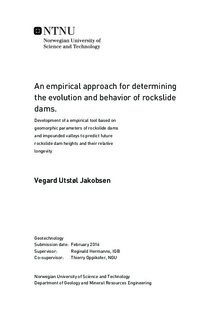An empirical approach for determining the evolution and behavior of rockslide dams. - Development of a empirical tool based on geomorphic parameters of rockslide dams and impounded valleys to predict future rockslide dam heights and their relative longevity
Master thesis
Permanent lenke
http://hdl.handle.net/11250/2382227Utgivelsesdato
2016Metadata
Vis full innførselSamlinger
Sammendrag
The secondary consequences of rock slope failure poses a threat to people living in Norwegian valleys. Blockage of rivers cause flooding upriver. Catastrophic breaching of the dam poses as major threat to people living beneath the dam. This master thesis introduces a tool that predicts dam height of future rock slope failures. The tool is created on the basis of a geomorphic analysis of rockslide dams in the southwestern parts of Norway (Jakobsen, 2015). The tool is an empiric equation that considers dam volume and valley width as major factors influencing dam height . The parameters used were chosen based on a 2d covariance-analysis on the geomorphic parameters. The database used to determine the empiric equation contain 19 elements.
dam height=(dam Volume)/(2,76E+05) e^(-(valley width)/(8,03E+02))- (valley width)/(6,66E+01)+31,12
Dimensionless blockage index considers catchment area (Ab), dam volume (Vd) and dam height as the main factors that determine the stability of rockslide dams (Ermini & Casagli, 2003). The stability of future rockslide dams can be assessed by replacing dam height with the equation above.
DBI=log((A_b*(V_d/(2,76E+05) e^(W_v/(8,03E+02))-W_v/(6,66E+01)+31,12))/V_d )
Other factors influence the stability of rockslide dams. The character of the carapace governs the resistance of the dam against continuous erosion (Weidinger, 2011). Grainsize analysis of the rockslide dams; Månavatnet and Gloppedalsura illustrate how the character of the carapace influences the stability, and hence the longevity of rockslide dams.
